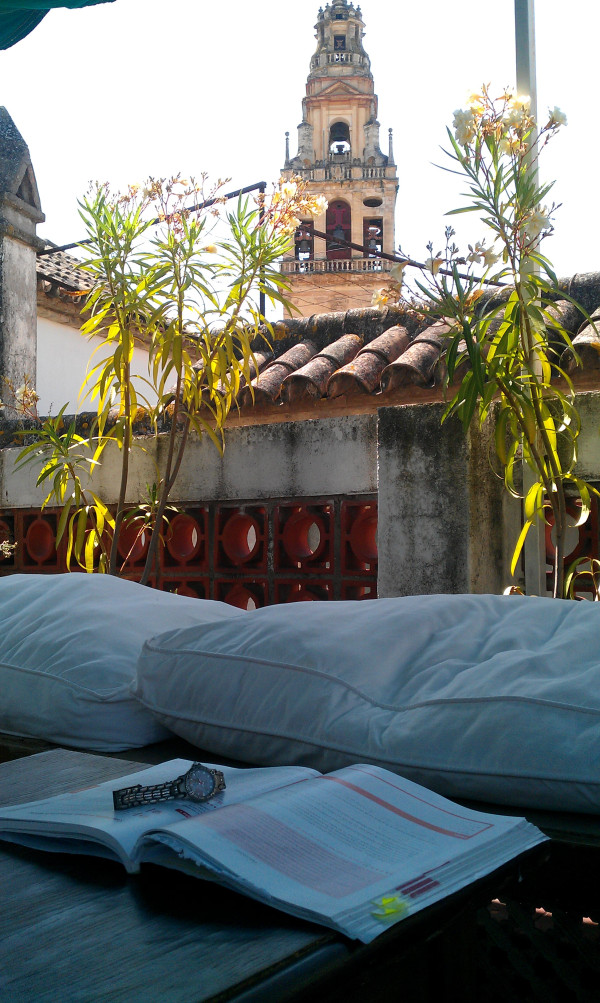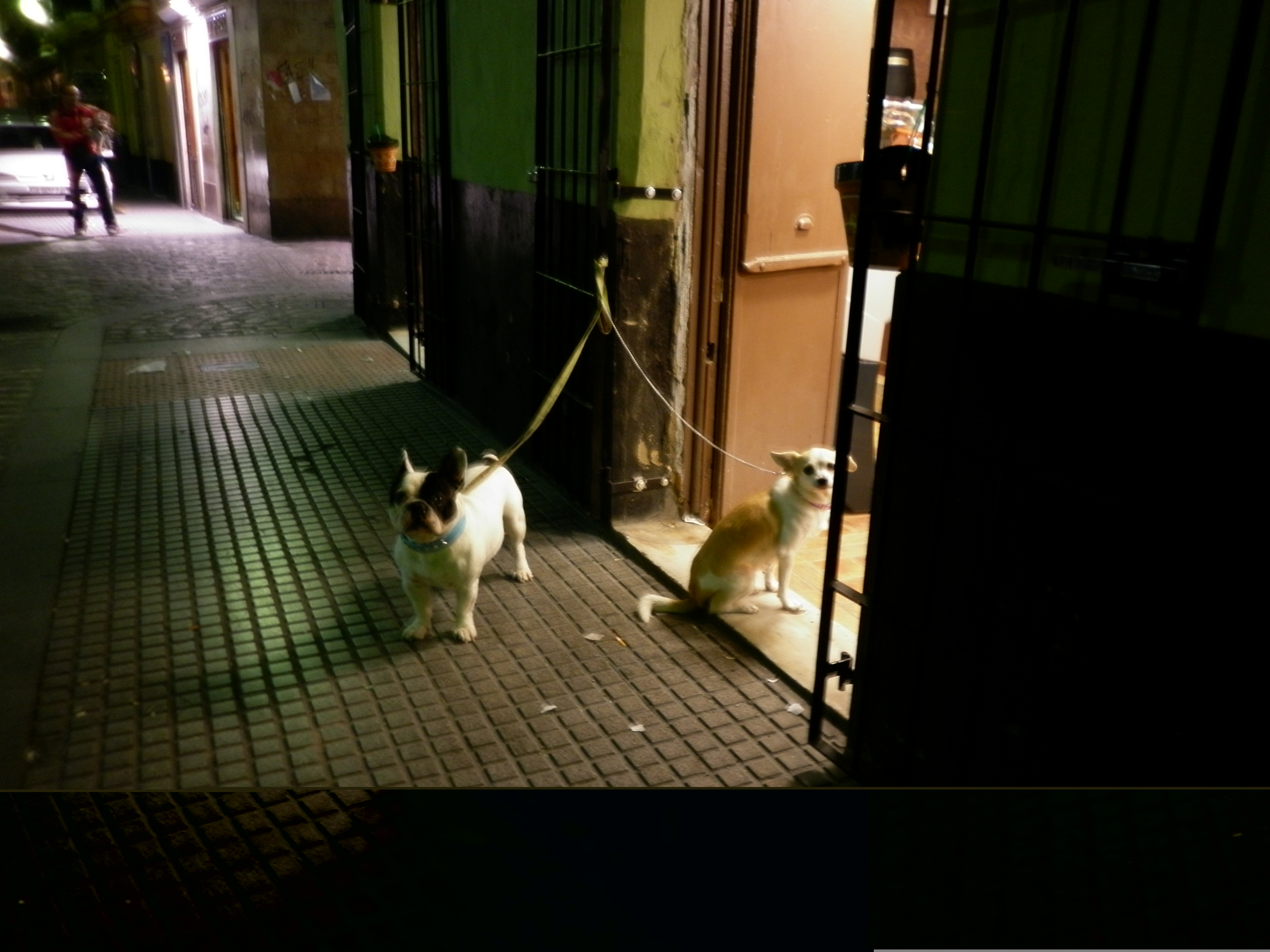updated with the help of Agasel in November 2015
A la bim! A la bahm! A la bim bohm bahm!
I expected a rousing Thursday! from my six year olds, but instead got “El día del examen de Miss Cat!”
Call it what you want – D-day, DELE-day, Run-and-hide-under-the-Cronómetro-book day, but November 17th was finally upon me. My pencils all sharpened, I hightailed out of work an hour early and took the train to Cádiz.
After nearly a year of toying with the idea, buying the prep books and finally buckling down to study, I got around to taking that stupid thing.
Psst! The format changed. Like, really, really drastically throw-your-stupid-refranes-book-in-the-hogueras changed. But, when I walked into the International House in Cádiz, I kind of didn’t know this, despite Lauren’s warnings and even the Instituto Cervantes announcing it. Alas, there were no books available for the new C1 or C2 formats, so I gleefully skipped over the grammar sections and watched an insane amount of news in Spanish. Because, duh, the DELE don’t like no tontos.
The city of Cádiz sat quiet and refreshingly beautiful, what with the haze of cheap rum and 16-year-old vomit lifted on a non-Carnaval night. The air was chilly on the peninsula, so I wrapped my arms tightly around my body and followed my phone’s GPS to my testing site, the International House Cádiz, a language school with academies around Spain.
The lobby resembled my elementary school’s, just brighter and not straight out of the 70s. My fellow testees hailed from all around the globe, brought together by our common language – castellano. I introduced myself to Marina, the exam coordinator, who was just a few months older than me and British, despite a Spanish name and flawless written Spanish.
The DELE exam in the superior levels are composed of four parts that examine your destrezas integradas, or your ability to understand, interpret and express yourself in Spanish. This means that rather than having a section simply dedicated to listening and answering multiple choice questions, you’ll be asked to listen to some kind of speech, short dialogue or conference and then speak or write about it. These competencies are the examen oral, the comprehensión lectiva, the competencia auditiva and the destrezas básicas, an evil hybrid of interpretation: audición e expresión escrita.
I followed Marina up a tight, winding staircase to the top floor. My bag and coat joined two others: one was the girl completing her oral exam in front of the judges, the tribunal, and the other preparing her…wait! She’s preparing something?
At 8 o’clock sharp (bravo, Spain!), Marina led me into a small classroom that had remnants of a young learners class in it. In front of the sturdy table sat two stark white folders. “Option 2 is a bit shorter,” Marina said as she pulled the door behind me. I read : La participación de jóvenes el el proceso político.” Ew, no. Option 1 it would have to be, a topic debated and groaned about in the halls of St. Mary’s: Spain’s push for the retirement age to be changed to 67 from 65. Coming from a long day of work, it seemed like something I could talk about when giving my personal opinion.
During the 20 minutes given to read the article enclosed in the folders, the candidato must read and take notes to prepare a four-to-six minute speech about the topic. Then, the interviewer will give the candidate the opportunity to establish and defend his opinion. Finally, the candidate is presented with a hypothetical situation and four photos, and he must talk about it and choose the best picture of the situation, defending the decision.
By 8pm, the tribunal had already seen well more than a dozen candidates. The handle to the door was icy cold as I pulled it shut, and I immediately regretted my decision to wash my hands in the bathroom – a soap dispenser disaster had left a huge stain on the lower half of my dress. I hastily explained my disheveled appearance and accepted their laughter.
After a few basic questions about how I ended up in Spain and how I learned Spanish, I gave my presentation, focusing on the article’s scientific evidence for abhorring the law proposal. The first few sentences felt choked, but noticing that the interviewer wasn’t writing anything on the blank paper before me, I suddenly felt eased. Being the last interviewee of the day, the interrogation seemed quick. Using my own experience teaching, I spoke easily about my own hesitations at the new proposal.
After completing the third section – four pictures of work situations and speaking about which suited my personality best – I gathered my lone bag and said goodbye to Marina, knowing we’d see each other in 12 hours. Bursting into the cold air, I was relieved that Gustav, a tall Swede, had opted to switch with me and do his entire exam Friday, leaving me to get the most worrisome part out-of-the-way.
After a quick stroll around the star-shaped peninsula that the old city sits on, I had two beers and some pizza (hey, I earned it!) before retiring to my hotel. The long week at work, coupled with sheer mental exhaustion, made for a heavy párpados.
The following morning, I reached the testing center. Fourteen names appeared on the door immediately off the lobby – a long, thin room with NIVEL C1 written in messy script on the whiteboard. ¿Catherine? Candidata cuatro, José Manuel, the tribunal boss, said, a slight smile crossing his face. I wished him a good morning and laid my eraser, three sharpened pencils and a pack of tissues on the table ahead of me and settled in for four hours of castellano. When we were all seated, JM explained the last-minute instructions – we had to use the pens provided, were allowed to mark up test booklets and that there was a slight mistake on the oral competency exam.
I had found the copy of last year’s C1 exam online and quickly reviewed its contents while we waited for 9am to hit. Short dialogues were new on the listening section. And there were no narrative stories to write. I took a quick glance around. People were rubbing their heads, crossing themselves. I said a quick prayer: please don’t let this 300€ have been in vain. José Manuel looked at us and dropped his hands. You may begin, he announced.
The morning session before a break had two parts: the reading and listening. I grabbed the pen and got down to business on the reading. During the 90 minute exam, one can allow about 15 minutes per each of the five tests, called tareas. The first (if memory serves me right) is a formal text – contract, meeting minutes, etc. – followed by a series of multiple choice questions. I tend to score higher on the scientific tests, so this was a piece of cake, responding to questions about proposals of an apartment building’s neighbor assembly. The second task is a narrative text with paragraphs missing. Following the broken piece are seven short paragraphs. The candidate must find the correct six passages, thus omitting one of the false entries. I was delighted to have a passage about travel, but this section proved to be the most difficult for me. Blame it on narrative journalism classes. The third text was a scientific article about the improbability of life on Mars with a few straightforward multiple-choice questions, and then came the fun part: reading six or eight museum exhibit announcements, and answering short questions about them.
For example: ¿Cúal de las exhibiciones tiene actividades complementarias? Which of the exhibit has conferences, contests, etc. I would then have to match the correct exhibition to the description. The fifth and final section was the grammar, where prepositions and subjunctive conjugations were left out, and the candidate must choose the correct option out of three given. There were 14 questions, which I finished rapidly. I had just enough time to quickly check to be sure the bubbles were filled in correctly before JM announced, ¡Lápices sueltas! and even took a pen out of another candidate’s hand.
The listening test was much the same: four tareas with 30 associated questions. While on older models of the exam were simply listening and answering true/false and multiple choice questions, the new version of the exam is again focused on those destrezas – using the language to make educated guesses.
Tarea 1 was the toughest, as the candidate had to listen to a conference and fill in six blanks from a pool of 13 answers, all of which are very similar. I had to listen to a woman talk about the practical use of great thinkers’ ideas. Yawn. Being a subject I had no interest in, it was difficult to focus my brain entirely. Next, in Tarea 2, there are eight questions that follow two short dialogues. the candidate must identify specific details or feelings and choose from three or four multiple choice answers. The third section is the same listening as before; listening to a lecture and selecting multiple choice questions. Finally, Tarea 4 presents short dialogues that express emotions or specific information, and the candidate, again, chooses the best answer from three.
As a tip, use the short breaks to read ahead in the questions and understand them completely. The listening exam passes quickly because you have to work at the pace set by the audio tracks. Thankfully, nearly all of the audiciones were easy to understand and the accents clear. I was also sitting directly in front of the CD player as candidate 4, which was to my advantage.
I burst into the bright sun, thankful for an extra jolt of endorphins and a quick coffee. Inside a small sweets shop, I bought PEZ – remembering my high school coach’s acronym – pure energy and zip – and popped the whole thing in my mouth for good measure, as the writing section would be the most difficult for me. The 30-minute break alloted passed quickly, but I was getting antsy to finish.
The final written section of the exam is the combination listening and written exam. On four short, lined pages provided by the testing site, we’d have to complete two tasks. As the Novio was helping me prepare, he said that my stinging complaint letters deserved an A+, but my narrative writing was unfocused and messy.
On the exam model, there are two parts: the first requires one to listen to an eight- to ten-minute speech, take notes, and then write an expository essay with the author’s opinion at the end, taking note of word count. Then comes a choice between a complaint letter and a narrative. Clearly, I chose the complaint letter and had to write to my city hall calling blasphemy against the lack of cultural programming for senior citizens. The long essay was a pain in the culo – ten minutes of someone droning on about the conservation of fossil fuels in marginalized communities. In the end, I had to squeeze my words into the papers provided and hastily count words, but closing my booklet two minutes and sliding it to the corner of my paper, I took a long exhale and slumped in my chair. It was finished. Terminado. Finito. Acabado. As I stood up to collect my bags, I saw people scribbling to finish and sweat collecting on brows.
I felt good. As the maximum number of points is 100, and one must score a 33 on each section (Yeah, I don’t understand that math either…), I figured I’d done the required for an APTO score (adequate) and would be awaiting a certificate in a few months. In fact, I think I could have done the C2, too, with a bit more discipline and hours dedicated to studying. Marina was nowhere to be found, so I called the Novio to tell him it was all done, popping chuces into my mouth as a reward. I finally relaxed on the train, looking forward.
While I may not need an Instituto Cervantes-issued ticket for a job any time soon, having to get back in the study mode and do something else but enjoy the sunshine and siestas was good for me (and my wallet, aside from the books and actual exam). I won’t find out my score for another 6-8 weeks, but I can rest easy note having a date looming over my head.
You can find the model on the Instituto Cervantes website by clicking here and downloading the PDF. Here are the testing dates for 2017.
Update: I passed my DELE exam, scoring a near-perfect score in both reading and writing. My listening score was average, though my speaking section was dismal. I went in overconfident yet nervous, and by not adhering to the exam specifics, I probably sounded like an idiot.
Have you ever taken a DELE exam? What helped you study? Read my tips for studying for the DELE exam here.









I had a very similar experience today–I took the DALF (diplome approfondi de langue francaise) level C1, which is the equivalent in French. Now that these language exams are over, it’s time to celebrate:-) I’m sure you passed!
Muchas felicidades! Quiero hacer lo mismo con el C1, pero estoy un poco nervioso sobre mi capacidad….especialmente xk no hablo castellano aqui. bllerrrrgggg.
Put up a photo of your fancy certificate when you get it!
¡Qué me dices! The speaking part was really not too difficult once I got over feeling self-conscious about the stain. You’ll do great!!
Wow, this exam is SO intimidating! I’m sure you passed with flying colors!!!
Yay! I’m glad it’s over. I was going to do it, but only if I move to Spain eventually…here, it’s not really worth anything.
When I was doing practice exams, I found the accents from other countries to be harder to understand because I was just so used to hearing the castellano accent. Maybe you have an advantage in that you hear more variety in Sevilla? I don’t know. But I’m so bad at understanding Caribbean accents.
Read this again after seeing your post. Maybe listen to some radio stations from PR/Cuba/DR, it might start to click once you get some more exposure. Where did you find sound files of the different accents used for the practice exams? Or did they come with your book?
And Cat, it costs 300€?! I had no idea!
Ains, 300€, no!! The test depends on where you take it and what level – it was 175 for the exam, I think, but I had to travel to Cádiz and stay over night, plus bought the two practice books.
That sounds ridiculously intense. Congratulations on being done!
Congrats Cat!!
Congrats to you! Thanks for describing the changes. I took the C2 last August before they changed the format but was 2.5 points away from passing. Hopefully the differences don´t make it too much more difficult.
Thanks! I passed by just 2 points, as my oral scores were much lower than I expected. I think they took out the most difficult parts for me, and instead made the exams more about using more than one language skill at a time to answer them. A ver si hay suerte and you pass next time around!
Is the Cronómetro book apporpriate for C1 and C2? I’m not aware that there is one specifically for C1. I want to do the C1 exam but don’t want to shell out for a book that’s going to be too high level- the C1 is challenging enough as it is…
Thanks.
Hi, sorry for the dealy – was traveling! Which Cronómetro book? I would over prepare if I were you. I thought the C1 was a piece of cake and passed with just a few points to spare. If there is no C1 book, then get ythe C2. The Crono is an excellent prep course as it is. Suerte!
Hi, thanks for the reply.
I was referring to the C2 book, but according to the publisher’s website (link below if you’re interested) there is a C1 coming out very soon. I’ve e-mailed them to ask when, I’ll report back if and when they reply.
http://www.edinumen.es/index.php?page=shop.product_details&category_id=18&flypage=flypage.tpl&product_id=454&option=com_virtuemart&Itemid=4&lang=es&vmcchk=1&date=2012-04-01
Great, thanks Luis!
I like that the exam took place in Cadiz. Home to the most unintelligible Spanish dialect there is.
Haha, I lived with a girl from caí, so I’ve got a few words that sound completely gaditano. I did it in Cádiz because the C1 wasn’t available in Seville. Imagine that! Are you thinking of taking it?
Yes, yes, yes! The Cronómetro book has changed to reflect the new format. I just picked up my freshly minted certificate today!! Are you fdoing C1 or C2? Sorry, just read the pingback (thanks for linking!!).